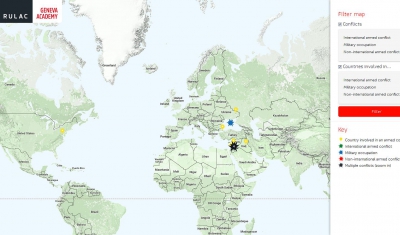International Humanitarian Law Applies to the Armed Confrontations between Mexico and the Jalisco Cartel New Generation


Geneva Academy
12 February 2019
In Mexico, there has been armed violence between the government and a number of cartels, as well as between such cartels over the past decades.
In this context, our Rule of Law in Armed Conflict (RULAC) online portal concludes that Mexico and the Cartel Jalisco Nueva Generación (CJNG, Jalisco Cartel New Generation) are parties to a non-international armed conflict (NIAC).
Classification as a NIAC Triggered by the Level of Armed Violence and the CJNG’s Degree of Organization
Two criteria are used to assess whether a situation of armed violence amounts to a NIAC under international humanitarian law (IHL): the level of armed violence must reach a certain degree of intensity that goes beyond internal disturbances and tensions, and at least one side to the conflict must be a non-state armed group that exhibits a certain level of organization.
‘Regarding the armed confrontations between the Mexican armed forces and the CJNG, we considered that both criteria are met and that, therefore, the IHL of NIACs applies in addition to international human rights law’ explains Dr Chiara Redaelli, Research Fellow at the Geneva Academy.
‘On the other hand, albeit other cartels have been engaging in armed confrontations both against each other and against the government, their armed groups do not meet the organisation requirement and thus are not parties to a non-international armed conflict in Mexico’ she adds.
Sharp Increase of Armed Violence with the CJNG
Over the past years, Mexico has pursued the so-called kingpin strategy, whereby it has arrested or killed the leaders of the major drug cartels operating in the country. While this has contributed to stopping the activities of a number of notorious members of the criminal organizations, it has also led to a fragmentation of the Mexican criminal landscape.
In this context, several relatively small and extremely violent cartels have emerged and have posed unprecedented challenges to the government with levels of violence increasing sharply and dramatically.
The CJNG is a clear example of a criminal organization that emerged as a result of the aforementioned kingpin strategy. It was created in 2010 following the death of the former Sinaloa Cartel leader Ignacio Coronel, alias ‘Nacho’, killed by the Mexican security forces. The power vacuum caused by Nacho’s death triggered an internal struggle that led to the creation of the CJNG.
In response to a sharp and dramatic increase of violence and armed confrontation between the government and the CJNG, the Mexican government passed in December 2017 the Internal Security Law, which authorises the army and navy personnel to be deployed in order to combat national security risks.

A Well-Organized Cartel that Meets the Organization Threshold
‘In spite of the paucity of information regarding the CJNG’s internal structure, several factors, including its capacity to purchase and manufacture weapons, to organize and carry out military operations, and its control of some parts of the Mexican territory, led us to conclude that the cartel meets the organization requirement’ explains Dr Redaelli.

About RULAC
The RULAC database is unique in the world in that it legally classifies situations of armed violence that amount to an armed conflict – international or non-international – under international humanitarian law (IHL).
‘This is crucial because IHL applies only in armed conflicts. Before humanitarian players, civil servants or academics can invoke IHL or analyze whether IHL was violated, they must know whether it applies. Outside armed conflicts, only international human rights law applies’ underlines Marco Sassòli, Director of the Geneva Academy.










